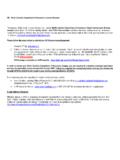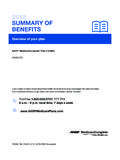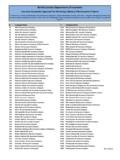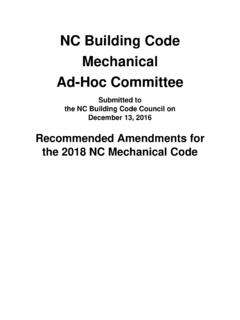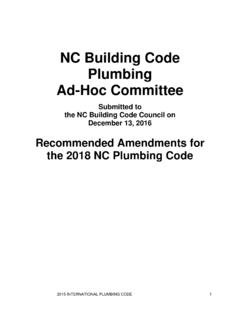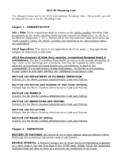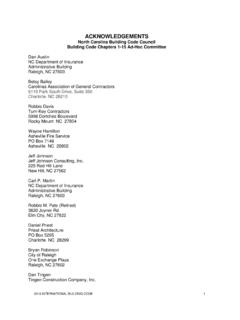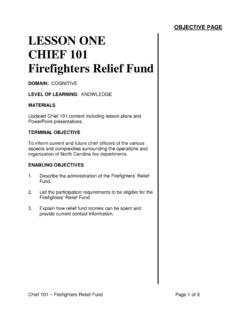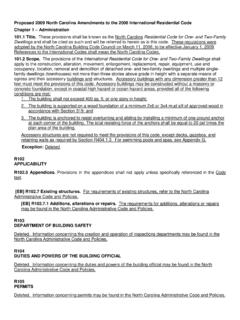Transcription of R602.10 Code and Commentary for 2012 NC Residential …
1 code and Commentary for 2012 NC Residential code final 03/06/13. Commentary italicized and printed in red 1. section -- provides charging language for two simplified bracing approaches (isolated panel and continuously sheathed), an engineered approach, the IRC 2012 provisions and APA. SR-102. 2. section provides bracing methods and materials common to both simplified methods and is non-exclusive. 3. section simplified isolated panel bracing (for low wind only, 90 and 100 mph). 4. section simplified continuous bracing (for up to 110 mph, wind); this could be expanded to 130 mph. 5. section provides engineering approach that would be applicable to any wind zone within scope; provides means of engineering consistent with NCBC bracing provisions to promote competitive value of engineered solutions in a manner exactly equivalent to the NCBC. 6. section provides various load path details applicable to any prescriptive method important to overall building performance and connectivity for any bracing method.
2 Wall bracing. Buildings, and portions thereof, shall be braced in accordance with one or more of the following sections using bracing materials and methods complying with section and load path detailing in accordance with section : 1. Isolated panel bracing per section , 2. Continuous sheathing per section , 3. Engineered design per section , or 4. 2012 International Residential code (IRC). 5. SR-102 as published by APA, The Engineered Wood Association with limitations indicated in this document. Note: code references in SR-102 are referencing the 2012 IRC. The selected bracing method or combination of methods is at the option of the permit holder and not the inspections department. items 1 and 2 are prescriptive and do not require the seal of a registered professional. Where a building, or portion thereof, does not comply with section , section , or section , those portions shall be designed and constructed in accordance with section Bracing materials and methods.
3 Wall bracing materials and methods shall comply with Table Table catalogs materials and bracing methods used in the prescriptive methods of section (isolated panel method) and section (continuous sheathing method). Any of these methods may be used for engineered solutions at the discretion of the designer. When using the prescriptive methods the type of bracing will be selected by the permit holder. 1. Table BRACING METHODS1, 2. Method Minimum Minimum Brace Connection Criteria Illustration of Brace Material Panel Length or Fasteners Spacing Bracing Method Thickness or Brace Angle (illustrates method Size only, not location). LIB 1x4 wood brace 45o angle for 2-8d common Per stud and Let-in Bracing (or approved metal maximum 16 oc nails or 3-8d (2- top and brace installed per stud spacing3 1/2 long x bottom plates manufacturer instructions) dia.). nails DWB (1 48 2-8d (2-1/2 Per stud and Diagonal wood nominal) long x top and boards diameter) or 2 bottom plates 1-3/4 long staples WSP 3/8 48 4 6d common nail 6 edges 12.
4 Wood structural or 8d (2-1/2 field panel long x . diameter) nail See Table (3). SFB 48 4 1-1/2 long x 3 edges 6 . Structural dia. field Fiberboard Galvanized Sheathing roofing nails GB 96 for use with Min. 5d cooler 7 edges 7 . Gypsum Board nails or #6 field Installed on both 48 for use with screws sides of wall PCP 48 1-1/2 long, 11 6 on all Portland cement (maximum gage, 7/16 framing plaster 16 oc stud diameter head members spacing) nails or 7/8 . long, 16 gage staples CS-WSP5 3/8 24 adjacent to Same as WSP Same as WSP. Continuously window not more sheathed WSP than 67% of wall height; 30 . CS-SFB5 adjacent to door or Same as SFB Same as SFB. window greater Continuously than 67% and less sheathed SFB than 85% of wall height. 48 for taller openings. PF 7/16 See Figure See Figure See Figure Portal Frame6 Table Notes: 1. Alternative bracing materials and methods shall comply with section 105 of the North Carolina Administrative code and Policies, and shall be permitted to be used as a substitute for any of the bracing materials listed in Table provided at least equivalent performance is demonstrated.
5 Where the tested bracing strength or stiffness differs from tabulated materials, the bracing amount required for the alternative material shall be permitted to be factored to achieve equivalence. 2. 2. All edges of panel-type wall bracing shall be attached to framing or blocking, except GB bracing horizontal joints shall not be required to be blocked when joints are finished. 3. Two LIB braces installed at a 60o angle shall be permitted to be substituted for each 45o angle LIB brace. 4. For 8-foot or 9-foot wall height, brace panel minimum length shall be permitted to be reduced to 36-inch or 42-inch length, respectively, where not located adjacent to a door opening. A braced wall panel shall be permitted to be reduced to a 32-inch length when studs at each end of the braced wall panel are anchored to foundation or framing below using hold-down device with minimum 2,800 lbs. design tension capacity.
6 For detached single story garages and attached garages supporting roof only, a minimum 24-inch brace panel length shall be permitted on one wall containing one or more garage door openings. The 24 braced wall panel length is intended to be located adjacent to the garage door opening. 5. Bracing methods designated CS-WSP and CS-SFB shall have sheathing installed on all sheathable surfaces above, below, and between wall openings. 6. For purposes of bracing in accordance with section , two portal frame brace panels with wood structural panel sheathing applied to the exterior face of each brace panel as shown in Figure shall be considered equivalent to one braced wall panel. EXTENT OF HEADER WITH DOUBLE PORTAL FRAMES (TWO BRACED WALL PANELS). EXTENT OF HEADER WITH SINGLE PORTAL FRAME. (ONE BRACED WALL PANEL). 2' -18' ROUGH FRAMED WIDTH OF OPENING. FOR SINGLE OR DOUBLE PORTAL. 4' MAX PONY TENSION STRAP (ON.)
7 WALL HEIGHT OPPOSITE SIDE OF. SHEATHING). MIN. 3" X 11-1/4" NET HEADER (STEEL BRACED WALL LINE. HEADER PROHIBITED ONLY WITH PF) CONTINUOUSLY SHEATHED. WITH WOOD STRUCTURAL. FASTEN SHEATHING TO HEADER WITH 8D PANELS. FASTEN TOP PLATE TO. 12' MAX TOTAL WALL HEIGHT. COMMON OR GALVANIZED BOX NAILS IN 3" GRID. HEADER WITH TWO. PATTERN AS SHOWN. IF NEEDED PANEL ROWS OF 16D SINKER. HEADER TO JACK-STUD STRAP ON BOTH SIDES SPLICE EDGES SHALL NAILS AT 3" TYP. 10' MAX. PANEL HEIGHT. OF OPENING OPPOSITE SIDE OF SHEATHING; OCCUR AND BE. STRAP CAPACITY SHALL EQUAL 1,000 LBS. OR ATTACHED TO. 4,000 LBS. WHEN PONY WALL IS PRESENT COMMON BLOCKING. WITHIN 24" OF WALL. MIN. DOUBLE STUD FRAMING COVERED WITH MIN. MID- HEIGHT. ONE ROW. MIN. 7/16" WOOD. 7/16" THICK WOOD STRUCTURAL PANEL OF 3" NAILING IS. REQUIRED IN EACH STRUCTURAL PANEL. SHEATHING WITH 8D COMMON OR GALVANIZED. PANEL EDGE. SHEATHING. BOX NAILS AT 3" IN ALL FRAMING (STUDS, BLOCKING, AND SILLS) TYP.
8 TYPICAL PORTAL. MINIMUM PANEL LENGTH. FRAME CONSTRUCTION. WALL HEIGHT, ft. MIN. 2X4 STUDS WITH. 8 9 10 11 12. PONY WALL HEIGHT UP TO. PANEL LENGTH, in. 16 18 20 22 24 2'; MIN. 2X6 STUDS WITH. MIN. DOUBLE POST. PONY WALL HEIGHT. (KING AND JACK STUD). GREATER THAN 2'. NUMBER OF JACK. MIN. (2) 1/2" DIAMETER ANCHOR BOLTS STUDS PER TABLES. INSTALLED PER WITH 2"x2"x3/16" PLATE (1) & (2). WASHER. ANCHOR BOLTS PER. section OVER CONCRETE OR MASONRY BLOCK FOUNDATION. (2) FRAMING ANCHORS. APPLIED ACROSS. SHEATHING JOINT WITH A. WOOD STRUCTURAL PANEL NAIL SOLE PLATE CAPACITY OF 670 LBS IN. SHEATHING TO TOP OF BAND OR TO JOIST PER THE HORIZONTAL NAIL SOLE. RIM JOIST TABLE (1) DIRECTION PLATE TO JOIST. PER TABLE. (1). WOOD STRUCTURAL PANEL. SHEATHING OVER. APPROVED BAND OR RIM. JOIST. OVER RAISED WOOD FLOOR - FRAMING ANCHOR OPTION APPROVED BAND. OR RIM JOIST. ATTACH SHEATHING TO. BAND OR RIM JOIST WITH.
9 WOOD STRUCTURAL. OVERLAP. NAIL SOLE PLATE 8D COMMON NAILS AT 3". 9-1/4". PANEL SHEATHING. MIN. TO JOIST PER TOP AND BOTTOM NAIL SOLE. CONTINUOUS OVER BAND. TABLE (1) PLATE TO JOIST. OR RIM JOIST. PER TABLE. (1). WOOD STRUCTURAL PANEL. SHEATHING OVER. APPROVED BAND OR RIM. OVER RAISED WOOD FLOOR - OVERLAP OPTION JOIST APPROVED BAND. OR RIM JOIST. FRONT ELEVATION section . For SI: 1 inch = mm, 1 foot = 305 mm, 1 lb = N. Figure Method PF Portal Frame Construction 3. Isolated Panel Bracing. Limitations. The conventional bracing requirements of section shall be limited to the following conditions of use: 1. Basic design wind speed shall not exceed 100 mph, Exposure Category B. 2. Bracing methods shall be LIB, DWB, WSP, SFB, GB, PCP, and PF in accordance with Table 3. Length of the house is limited to 75 feet. Overall plan length shall not exceed 3 times the overall plan width. The multiple circumscribed rectangle method from may be applied to the method set forth in this section .
10 4. Wall height at each story level shall not exceed 10 feet. 5. Roof eave-to-ridge height shall not exceed 10 feet unless the roof is considered as an additional story for the purpose of determining bracing amounts required. 6. Except when used for bracing method GB, the interior side of exterior walls and both sides of interior walls shall be sheathed continuously with minimum -inch-thick gypsum wall board interior finish fastened in accordance with Table , or approved interior finish of equivalent or greater shear resistance. The intent of this provision is to recognize the strength that gypsum wallboard adds to braced wall panels on exterior walls. The gypsum wallboard may be omitted if the length of each braced wall panel without the gypsum board is multiplied by 7. Floors shall not cantilever more than 24 inches (607 mm) beyond the foundation or bearing wall below. 8. Townhouses shall be stabilized independently of adjacent units unless a design is provided to permit lateral load transfer between adjacent units.
